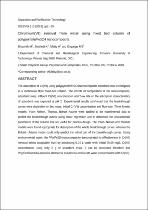 ResearchSpace
ResearchSpace
Chromium(VI) removal from water using fixed bed column of polypyrrole/Fe3O4 nanocomposite
JavaScript is disabled for your browser. Some features of this site may not work without it.
- ResearchSpace
- →
- Research Publications/Outputs
- →
- Journal Articles
- →
- View Item
| dc.contributor.author |
Bhaumik, M

|
|
| dc.contributor.author |
Setshedi, K

|
|
| dc.contributor.author |
Maity, Arjun

|
|
| dc.contributor.author |
Onyango, M.S

|
|
| dc.date.accessioned | 2013-05-21T08:18:45Z | |
| dc.date.available | 2013-05-21T08:18:45Z | |
| dc.date.issued | 2013-06-07 | |
| dc.identifier.citation | Bhaumik, M, Setshedi, K, Maity, A and Onyango, M.S. 2013. Chromium(VI) removal from water using fixed bed column of polypyrrole/Fe3O4 nanocomposite. Separation and Purification Technology, Vol.110, pp11-19 | en_US |
| dc.identifier.issn | 1383-5866 | |
| dc.identifier.uri | http://www.sciencedirect.com/science/article/pii/S1383586613001330 | |
| dc.identifier.uri | http://hdl.handle.net/10204/6735 | |
| dc.description | Copyright: 2013 Elsevier. This is a ABSTRACT ONLY. The definitive version is published in Separation and Purification Technology, Vol.110, pp11-19 | en_US |
| dc.description.abstract | The adsorption of Cr(VI) using polypyrrole/Fe3O4nanocomposite adsorbent was investigated in a continuous flow fixed-bed column. The effects of composition of the nanocomposite, adsorbent mass, influent Cr(VI) concentration and flow rate on the adsorption characteristics of adsorbent was explored at pH 2. Experimental results confirmed that the breakthrough curves were dependent on bed mass, initial Cr(VI) concentration and flow rate. Three kinetic models; Yoon–Nelson, Thomas, Bohart–Adams were applied to the experimental data to predict the breakthrough curves using linear regression and to determine the characteristic parameters of the column that are useful for process design. The Yoon–Nelson and Thomas models were found appropriate for description of the whole breakthrough curves, whereas the Bohart– Adams model could only predict the initial part of the breakthrough curves. Using environmental water, the PPy/Fe3O4nanocomposite demonstrated its effectiveness in Cr(VI) removal below acceptable level by processing 5.04 L water with initial 76.59 mg/L Cr(VI) concentration using only 2 g of adsorbent mass. It can be concluded therefore that PPy/Fe3O4media provides alternative solution to ameliorate water contaminated with Cr(VI). | en_US |
| dc.language.iso | en | en_US |
| dc.publisher | Elsevier | en_US |
| dc.relation.ispartofseries | Workflow;10755 | |
| dc.subject | Adsorption characteristics | en_US |
| dc.subject | Environmental water | en_US |
| dc.subject | Chromium(VI) | en_US |
| dc.subject | Adsorbent mass | en_US |
| dc.subject | Nanocomposite | en_US |
| dc.subject | Fixed bed column | en_US |
| dc.subject | Polypyrrole | en_US |
| dc.subject | Ameliorate water | en_US |
| dc.title | Chromium(VI) removal from water using fixed bed column of polypyrrole/Fe3O4 nanocomposite | en_US |
| dc.type | Article | en_US |
| dc.identifier.apacitation | Bhaumik, M., Setshedi, K., Maity, A., & Onyango, M. S. (2013). Chromium(VI) removal from water using fixed bed column of polypyrrole/Fe3O4 nanocomposite. http://hdl.handle.net/10204/6735 | en_ZA |
| dc.identifier.chicagocitation | Bhaumik, M, K Setshedi, Arjun Maity, and M.S Onyango "Chromium(VI) removal from water using fixed bed column of polypyrrole/Fe3O4 nanocomposite." (2013) http://hdl.handle.net/10204/6735 | en_ZA |
| dc.identifier.vancouvercitation | Bhaumik M, Setshedi K, Maity A, Onyango MS. Chromium(VI) removal from water using fixed bed column of polypyrrole/Fe3O4 nanocomposite. 2013; http://hdl.handle.net/10204/6735. | en_ZA |
| dc.identifier.ris | TY - Article AU - Bhaumik, M AU - Setshedi, K AU - Maity, Arjun AU - Onyango, M.S AB - The adsorption of Cr(VI) using polypyrrole/Fe3O4nanocomposite adsorbent was investigated in a continuous flow fixed-bed column. The effects of composition of the nanocomposite, adsorbent mass, influent Cr(VI) concentration and flow rate on the adsorption characteristics of adsorbent was explored at pH 2. Experimental results confirmed that the breakthrough curves were dependent on bed mass, initial Cr(VI) concentration and flow rate. Three kinetic models; Yoon–Nelson, Thomas, Bohart–Adams were applied to the experimental data to predict the breakthrough curves using linear regression and to determine the characteristic parameters of the column that are useful for process design. The Yoon–Nelson and Thomas models were found appropriate for description of the whole breakthrough curves, whereas the Bohart– Adams model could only predict the initial part of the breakthrough curves. Using environmental water, the PPy/Fe3O4nanocomposite demonstrated its effectiveness in Cr(VI) removal below acceptable level by processing 5.04 L water with initial 76.59 mg/L Cr(VI) concentration using only 2 g of adsorbent mass. It can be concluded therefore that PPy/Fe3O4media provides alternative solution to ameliorate water contaminated with Cr(VI). DA - 2013-06-07 DB - ResearchSpace DP - CSIR KW - Adsorption characteristics KW - Environmental water KW - Chromium(VI) KW - Adsorbent mass KW - Nanocomposite KW - Fixed bed column KW - Polypyrrole KW - Ameliorate water LK - https://researchspace.csir.co.za PY - 2013 SM - 1383-5866 T1 - Chromium(VI) removal from water using fixed bed column of polypyrrole/Fe3O4 nanocomposite TI - Chromium(VI) removal from water using fixed bed column of polypyrrole/Fe3O4 nanocomposite UR - http://hdl.handle.net/10204/6735 ER - | en_ZA |





